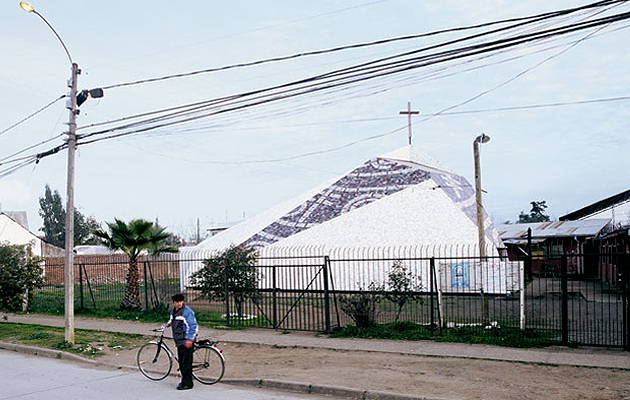|
The church’s faceted facade is meant to provide a durable shell (image: Cristobal Palma) |
||
|
“It’s hard to break a building that is already broken,” says Juan Pablo Corvalán of mischievous South American collective Supersudaca, whose new “Church-ita” in the Chilean city of Talca combines elegance with rugged pragmatism. Nestling in a small site on the outskirts of the city, this brave project deftly tempers social ambition with the tricky realities of the area. “Throwing stones is a local habit,” says Corvalán, describing how many of the city’s public buildings have been targeted by vandals and burned down, “so we needed an enclosure that could resist this and be easily repaired.” Yet their result is far from a fortified religious bunker. With a frugal budget of $60,000, the architects relied on salvaging as many of their materials as possible, from reclaiming industrial kiln bricks for the hard-wearing floor, to scavenging assorted lurid tile fragments for the facade. Working in collaboration with an artist, they have reinterpreted the religious narrative mosaic in the form of a tough protective shell, its bold graphic forms deviating from the figurative Catholic tradition. Instead, Corvalán explains, these shapes are details cropped from a painting by this artist of a walking figure of Jesus, “who looks more like Ringo Starr.” For the church to work as an open community hub, accessibility is key. The church’s folded skin hangs on a simple steel frame. Rising up above its scruffy neighbours, its faceted form avoids the hierarchical conventions of a front and rear facade. Instead, the church has been reconfigured as a multi-purpose open space, more covered plaza than enclosed building. “It is much more than a church,” says Corvalán, who developed the project in collaboration with his diploma students at the Universidad de Talca. Despite its name – “-ita” is diminutive in Spanish – the building acts as a new social heart for the community, incorporating a small library and canteen for the elderly along the perimeter of the site. And it has been avidly embraced by the local residents – the eager congregation had moved in and held services there before it was even finished.
The facade mosaics are made of reclaimed tiles (image: Cristobal Palma)
The glazing pattern echoes the faceted facade (image: Cristobal Palma)
The altar, under a diffused skylight (image: Cristobal Palma) |
Words Oliver Wainwright |
|
|
||






















